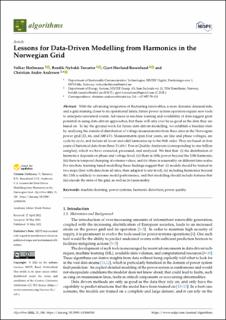| dc.contributor.author | Hoffmann, Volker | |
| dc.contributor.author | Torsæter, Bendik Nybakk | |
| dc.contributor.author | Rosenlund, Gjert Hovland | |
| dc.contributor.author | Andresen, Christian Andre | |
| dc.date.accessioned | 2022-09-19T14:43:28Z | |
| dc.date.available | 2022-09-19T14:43:28Z | |
| dc.date.created | 2022-06-20T08:59:31Z | |
| dc.date.issued | 2022 | |
| dc.identifier.citation | Algorithms. 2022, 15 (6), 188. | en_US |
| dc.identifier.issn | 1999-4893 | |
| dc.identifier.uri | https://hdl.handle.net/11250/3018994 | |
| dc.description.abstract | With the advancing integration of fluctuating renewables, a more dynamic demand-side, and a grid running closer to its operational limits, future power system operators require new tools to anticipate unwanted events. Advances in machine learning and availability of data suggest great potential in using data-driven approaches, but these will only ever be as good as the data they are based on. To lay the ground-work for future data-driven modelling, we establish a baseline state by analysing the statistical distribution of voltage measurements from three sites in the Norwegian power grid (22, 66, and 300 kV). Measurements span four years, are line and phase voltages, are cycle-by-cycle, and include all (even and odd) harmonics up to the 96 order. They are based on four years of historical data from three Elspec Power Quality Analyzers (corresponding to one trillion samples), which we have extracted, processed, and analyzed. We find that: (i) the distribution of harmonics depends on phase and voltage level; (ii) there is little power beyond the 13 harmonic; (iii) there is temporal clumping of extreme values; and (iv) there is seasonality on different time-scales. For machine learning based modelling these findings suggest that: (i) models should be trained in two steps (first with data from all sites, then adapted to site-level); (ii) including harmonics beyond the 13 is unlikely to increase model performance, and that modelling should include features that (iii) encode the state of the grid, as well as (iv) seasonality. View Full-Text Keywords: machine learning; power systems; harmonic distortion; power quality | en_US |
| dc.language.iso | eng | en_US |
| dc.publisher | MDPI | en_US |
| dc.rights | Navngivelse 4.0 Internasjonal | * |
| dc.rights.uri | http://creativecommons.org/licenses/by/4.0/deed.no | * |
| dc.subject | Machine learning | en_US |
| dc.subject | Power systems | en_US |
| dc.subject | Harmonic distortion | en_US |
| dc.subject | Power quality | en_US |
| dc.title | Lessons for Data-Driven Modelling from Harmonics in the Norwegian Grid | en_US |
| dc.title.alternative | Lessons for Data-Driven Modelling from Harmonics in the Norwegian Grid | en_US |
| dc.type | Peer reviewed | en_US |
| dc.type | Journal article | en_US |
| dc.description.version | publishedVersion | en_US |
| dc.rights.holder | © 2022 by the authors | en_US |
| dc.source.pagenumber | 19 | en_US |
| dc.source.volume | 15 | en_US |
| dc.source.journal | Algorithms | en_US |
| dc.source.issue | 6 | en_US |
| dc.identifier.doi | 10.3390/a15060188 | |
| dc.identifier.cristin | 2033232 | |
| dc.relation.project | Norges forskningsråd: 268193 | en_US |
| dc.source.articlenumber | 188 | en_US |
| cristin.ispublished | true | |
| cristin.fulltext | original | |
| cristin.qualitycode | 1 | |

